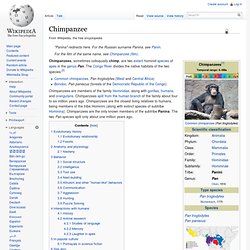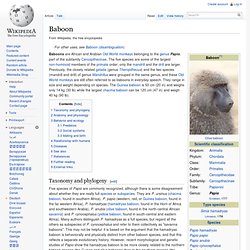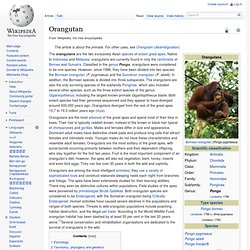

Hominidae. The Hominidae (/hɒˈmɪnɨdiː/; also known as great apes[notes 1]) form a taxonomic family of primates, including four extant genera: The term "hominid" is also used in the more restricted sense as hominins or "humans and relatives of humans closer than chimpanzees".[2] In this usage, all hominid species other than Homo sapiens are extinct.

A number of known extinct genera are grouped with humans in the Homininae subfamily, others with orangutans in the Ponginae subfamily. The most recent common ancestor of the Hominidae lived roughly 14 million years ago,[3] when the ancestors of the orangutans speciated from the ancestors of the other three genera.[4] The ancestors of the Hominidae family had already speciated from those of the Hylobatidae family, perhaps 15 million to 20 million years ago.[4][5] History[edit] Taxonomic history[edit] The classification of the great apes has been revised several times in the last few decades.
Especially close human relatives form a subfamily, the Homininae.
Chimpanzee. Chimpanzees, sometimes colloquially chimp, are two extant hominid species of apes in the genus Pan.

The Congo River divides the native habitats of the two species:[2] Chimpanzees are members of the family Hominidae, along with gorillas, humans, and orangutans. Chimpanzees split from the human branch of the family about four to six million years ago. Chimpanzees are the closest living relatives to humans, being members of the tribe Hominini (along with extinct species of subtribe Hominina). Baboon. Taxonomy and phylogeny[edit] Five species of Papio are commonly recognized, although there is some disagreement about whether they are really full species or subspecies.

They are P. ursinus (chacma baboon, found in southern Africa), P. papio (western, red, or Guinea baboon, found in the far western Africa), P. hamadryas (hamadryas baboon, found in the Horn of Africa and southwestern Arabia), P. anubis (olive baboon, found in the north-central African savanna) and P. cynocephalus (yellow baboon, found in south-central and eastern Africa). Many authors distinguish P. hamadryas as a full species, but regard all the others as subspecies of P. cynocephalus and refer to them collectively as "savanna baboons".
This may not be helpful: it is based on the argument that the hamadryas baboon is behaviorally and physically distinct from other baboon species, and that this reflects a separate evolutionary history. Gorilla. Gorillas constitute the eponymous genus Gorilla, the largest extant genus of primates by physical size.

They are ground-dwelling, predominantly herbivorous apes that inhabit the forests of central Africa. The genus is divided into two species and either four or five subspecies. The DNA of gorillas is highly similar to that of a human, from 95–99% depending on what is counted, and they are the next closest living relatives to humans after the chimpanzees (including bonobos).
Gorillas' natural habitats cover tropical or subtropical forests in Africa. Although their range covers a small percentage of Africa, gorillas cover a wide range of elevations. Etymology Evolution and classification Primatologists continue to explore the relationships between various gorilla populations.[8] The species and subspecies listed here are the ones upon which most scientists agree. Physical characteristics A skull of a gorilla Behavior and ecology Young gorilla in tree. Orangutan. Orangutans are the most arboreal of the great apes and spend most of their time in trees.

Their hair is typically reddish-brown, instead of the brown or black hair typical of chimpanzees and gorillas. Males and females differ in size and appearance. Dominant adult males have distinctive cheek pads and produce long calls that attract females and intimidate rivals. Younger males do not have these characteristics and resemble adult females. Orangutans are the most solitary of the great apes, with social bonds occurring primarily between mothers and their dependent offspring, who stay together for the first two years. Orangutans are among the most intelligent primates; they use a variety of sophisticated tools and construct elaborate sleeping nests each night from branches and foliage. Etymology The word was first attested in English in 1691 in the form orang-outang, and variants with -ng instead of -n as in the Malay original are found in many languages.
Taxonomy, phylogeny and genetics.